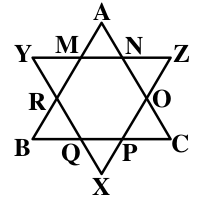1. Given an equilateral triangle T1 with side 24 cm, a second triangle T2 is formed by joining the midpoints of the sides of T1. Then a third triangle T3 is formed by joining the midpoints of the sides of T2. If this process of forming triangles is continued, the sum of the areas, in sq cm, of infinitely many such triangles T1, T2, T3,... will be
Show Similar Question And Answers
 ....
.... Powered By:Omega Web Solutions
Powered By:Omega Web Solutions
Sum of the area of all triangles = T$$_{1}$$ + T$$_{2}$$ + T$$_{3}$$ + ... $$Rightarrow$$ T$$_{1}$$ + T$$_{2}$$/$$4$$ + T$$_{3}$$/$$4^2$$ + ... $$Rightarrow$$ $$dfrac{T_{1}}{1 - 0.25}$$
$$Rightarrow$$ $$dfrac{4}{3}*T_{1}$$
$$Rightarrow$$ $$dfrac{4}{3}*144sqrt{3}$$
$$Rightarrow$$ $$192sqrt{3}$$
Hence, option D is the correct answer.